Strawberries are perennials which can be easily grown in containers and hanging pots. However, to grow them one has to choose the right type of plant and container. Read this Buzzle article to know about the types of containers available for growing strawberries.
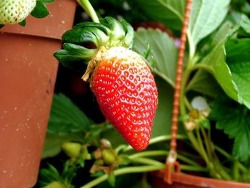
Heart-shaped, red, luscious strawberries have been relished by people for centuries. These fruits are not only tantalizing to the palate, but also highly nutritional. Have you ever thought of growing these gorgeous rubies within the four walls of your house? Well, it's true! You do not need a garden or even a flower bed to grow them. You can easily grow strawberries indoors in hanging pots and containers, placed on your windowsill. Let's find out more about growing strawberries at home.
Choosing the Right Type of Plant
For better yield, care has to be taken with respect to the type of strawberry plant. Strawberry plants are classified into 3 categories: June bearing, day neutral and everbearing. June bearing variety bears fruit for a 2 - 3 weeks period in June, and the fruit produced is larger than the other two categories. The day neutral type produces fruit all year round, while the everbearing type produces fruit twice or thrice a year; spring, summer and fall.
For growing strawberries indoors, the day neutral and everbearing varieties are best suited, since they produce very few runners. You can choose red alpine strawberries which come under the everbearing type, as they can grow comfortably in shady places. The day neutral variety requires cool temperatures and do not grow in hot surroundings. So depending upon the climate where you live, you can choose the appropriate type of plant. The best way to make sure that you have picked the right type of plant is by consulting a local greenhouse or nursery.
Choosing the Right Containers
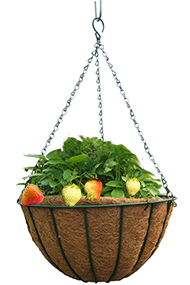 Hanging Basket
Hanging Basket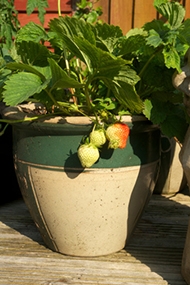 Ceramic Pot
Ceramic Pot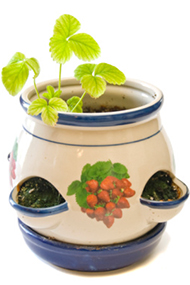 Strawberry Pot
Strawberry Pot
Since strawberries have shallow root systems, growing strawberries in pots and baskets is very easy. After deciding on the type of strawberry plant you want to grow, you must choose the container in which you want to grow them. The best part about strawberries is that, they grow beautifully in any kind of container. It's only the aesthetic value that differentiates the containers. You can either buy hanging baskets (with a durable rope or chain), fancy multi-plant containers, strawberry pots, etc. from online sellers, local garden supply centers or use tubs, pots, barrels, window boxes, cans, etc. to grow the strawberries. Though ceramic strawberry pots are the most preferred, they are quite expensive. If you choose hanging baskets, make sure they are 12 inches wide. If you decide to go in for containers, make sure that they are 8 - 10 inches deep. Whatever you choose, make sure the container has holes at the bottom, so as to ensure proper drainage. Strawberry plants should not be allowed to stand in stagnant and collected water. Also, remember to cover the bottom of the container with a fiber glass window screen, so that the soil doesn't get washed away along with the water. The advantage of choosing hanging baskets for growing strawberries is that one need not be worried about insect infestation and damage caused by slugs.
Appropriate Time to Plant Strawberries
The most appropriate time to plant strawberries depends on the climate of the region in question.
- Warm Climate: Planting can be carried out during fall.
- Cold Climate: Planting can be carried out in early spring.
- Indoor Cultivation: Planting can be done any time during the year
Soil Preparation Details
Strawberry plants require well-drained soil to thrive on. The soil or potting mix must be of good quality and should be mixed with compost. Before planting them, you should add fertilizer (liquid or control release fertilizer) to the soil, with the pH of the soil within the range of 5.3 - 6.5 for ideal results. The soil must be fertilized once a month and every 10 days when the plant has begun to bear flowers. Tomato feed serves as a good fertilizer since it is rich in potassium and provides the plant the necessary nutrition, which it lacks because it is placed in a basket or hanging pot.
Things to Remember while Planting
- Strawberries can be planted from seeds or from small saplings. If you are using seeds, then you require a good potting mix (mixed with compost). Water the potting mix and allow the excess water to drain before planting the seeds. However, remember that planting from seeds may not always be successful, so if you're a beginner, try buying the germ from the nearest nursery.
- To grow strawberries from saplings, ensure the saplings you've bought are healthy and disease free and before planting them, trim all their old leaves and runners.
- Also, trim the roots to about 4 - 5 inches in length, and place them in water for an hour before they are planted into the soil.
- While planting them, make sure that the crown of the plant is even with the soil and see to it that soil doesn't cover the crown, as the crown is the part where the leaves begin to grow.
- You can plant 3 - 6 plants in a basket or more if it's a multiple plant holder.
- The objective during the first 6 - 7 weeks is not fruit production but vegetative growth instead. Hence, remove all the buds from the plant. This will enable the plant to grow healthy and strong, and will ensure a good fruit yield in the future.
- Water thoroughly, preferably in the mornings and make sure no water collection occurs.
- Do not neglect the weeds. All throughout the plant's growing season, keep a check on weeds.
- As the flowers and fruit develop, trim all long runners, to get better yield.
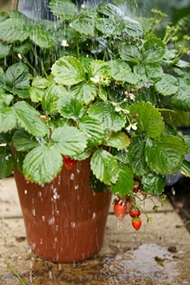
Watering the Plants
Although growing this fruit is not cumbersome or complicated, one imported factor directly related to the yield is 'watering'. The soil has to be well watered, yet not excessively watered. This is because water clogging can cause the roots to rot. Therefore, it's important to ensure the soil is not too wet after watering. A container with many drainage holes or hanging basket is suitable for the same.
Strawberries consist of 95% water, and if water is inadequately provided to the plant, then tiny, hard strawberries will be formed instead of the large juicy ones. Water the plants regularly by checking the dampness of the soil. If the soil feels dry, then water it and make sure the soil never dries out, however, do not over water the plant and do not let any water collect in the pot as this can prove deleterious to the plant. Some people also resort to drip irrigation, absorbing crystals, etc. to provide the right amount of water to the plant all along.
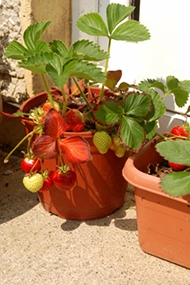
Sufficient Sunlight
Try to plant your strawberries on a cool day with a good cloud cover. Too much heat or sun exposure may damage new plants or stunt their growth. Minimum sun exposure at the time of planting will prepare the plants for full sun exposure during the growing season. The plants will require a minimum of 6 - 8 hours of sunlight, especially during the growing season. Moreover, 10 hours of sun exposure will be beneficial for stronger plant and better fruit. Hence, see that they are placed at places where adequate sunlight is available. The more sunlight the plants receive, the yummier the yield. In case of hanging baskets, rotate the plant during the day so that the entire plant receives equal amount of sunlight.
Furthermore, if the climate where you are living is very cold, it is advisable to bring the pots indoors during the cold nights. You can also use a grow lamp for giving sufficient light to your plant if the weather is too cold and does not allow exposure to the sun.
Protection from Pests
- It is advisable to place the strawberry plants above ground level because they are prone to invasion by slugs, birds, snails, red spider mites, aphids and thrips.
- By using hanging pots to grow your strawberry plants, you can avoid the slug problem and nets can be used to keep the birds away.
- Various insecticides and sprays are available to cater to the mite and snail problems.
- Certain fungal problems can also be encountered. White powder on the leaves and stem indicate that the plant has been infected with powdery mildew. In such cases fungicides have to be used.
Harvesting the Fruit
The time for harvesting strawberries is when the green has disappeared and the fruit turns bright red. However, the exact shade of red indicating the fruit's ripeness varies from type to type. Since strawberries grow in bunches, special care should be taken while harvesting. The ripe fruit must be carefully detached without causing any harm to the other unripe fruit. It is advised to pick the fruit during dry weather. The fruit must be detached in such a manner that the calyx of the plant remains attached to the fruit after separation.
Although strawberries are perennials, they produce fruit for only about 3 years, with the fruit quality diminishing with every passing year. Strawberry plants yield the best of their produce in the second year. Hence, the fruit produced in the second year is sweeter and of higher quality. The quality of the fruit deteriorates from the second year onwards, thus you can replace your plants every two years with new ones. Strawberries can be stored for about two days in the refrigerator, but for longer storage it is best to freeze them. Growing strawberries can be real fun and satisfying. Happy harvesting!






 Heart-shaped, red, luscious strawberries have been relished by people for centuries. These fruits are not only tantalizing to the palate, but also highly nutritional. Have you ever thought of growing these gorgeous rubies within the four walls of your house? Well, it's true! You do not need a garden or even a flower bed to grow them. You can easily grow strawberries indoors in hanging pots and containers, placed on your windowsill. Let's find out more about growing strawberries at home.
Heart-shaped, red, luscious strawberries have been relished by people for centuries. These fruits are not only tantalizing to the palate, but also highly nutritional. Have you ever thought of growing these gorgeous rubies within the four walls of your house? Well, it's true! You do not need a garden or even a flower bed to grow them. You can easily grow strawberries indoors in hanging pots and containers, placed on your windowsill. Let's find out more about growing strawberries at home. 



